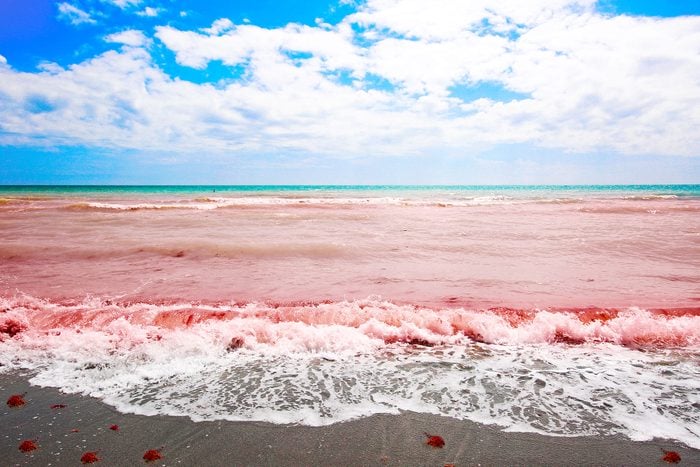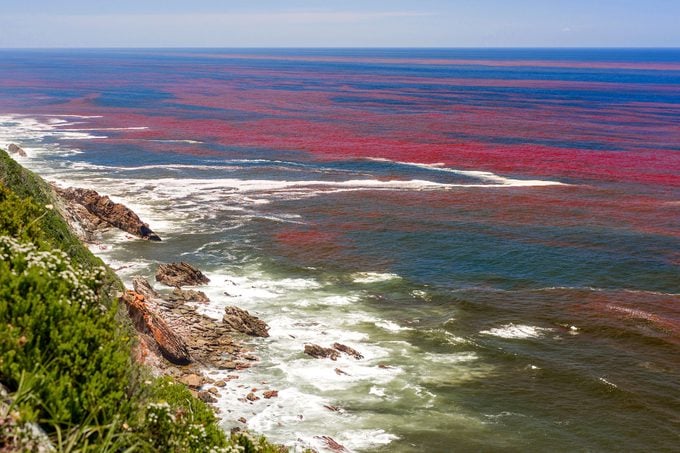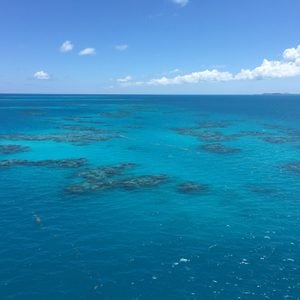If You See Red Ocean Water, This Is What It Means
Updated: Mar. 10, 2023

Discover what red tide is and what it means for humans and marine life.
There are so many fascinating things about the ocean, from its lush flora to the beautiful marine life. However, we still need to learn many things about it—including how to mitigate risk when certain algae reach concerning levels.
If you plan on swimming in the ocean soon, it’s important to be aware of what’s going on with it. One thing to keep an eye out for is red ocean water, which is also often called “red tide.” Here’s what you need to know about this phenomenon.
What is red tide?
Red tide is a term used to refer to a toxic organism. As its name suggests, it can cause red discoloration in the water. You may also hear red tide referred to by its scientific name, “Karenia brevis.” This organism multiplies and results in harmful algal blooms.
Scary enough, it also has health impacts on both marine life and humans—red tide works by creating a toxin as its defense mechanism. There’s a red tide breed that specifically returns to Florida’s Gulf Coast yearly, so do your research before you plan your Florida getaway.
According to the Florida Fish and Wildlife Conservation Commission, breathing issues in humans and death for marine life start when red tide levels are 10,000 cells per liter. Several places in Florida have red tide levels ranging from 10,000 to over 1 million cells per liter. In other words: Stay out of the water.
What does red tide do to people?

We already know that red tide can be fatal for fish, but does it have an impact on humans? Unfortunately, the answer is yes. Humans should avoid impacted beaches because if you inhale the toxin from red tide, you could experience respiratory symptoms. This includes a sore throat, wheezing or coughing.
Plus, there’s also the risk of skin irritation. You might experience sore eyes, burning or a rash if exposed to red tide waters. You must avoid the algae if you have breathing difficulties such as asthma.
Unfortunately, the impact of red tide can be even more detrimental to ocean life. It can spell nervous system issues, paralysis and even death for animals in the ocean.
Is red tide present in Florida right now?
Yes, red tide is present in Florida right now. This year, it was first noticed on Feb. 15 in a water sample from the Juno Beach Pier. However, at that time, the sample only tested positive for background levels of red tide, and no health impact was detected. The red tide was even completely gone when the water was tested again on Feb. 22. However, the issue has grown in intensity in recent weeks.
Red tide is impacting multiple counties in southwestern Florida, so before you head to the beach, be sure to do your research. Florida’s Fish and Wildlife Conservation Commission has stated that there have been reports of dead fish and respiratory symptoms in humans in several counties, including Collier, Charlotte, Sarasota, Manatee, Lee and Pinellas.
Can you swim in red tide?
In short, no, you should not swim in red tide. Because the amount of cells per liter is currently at the threshold that could make you ill, avoiding affected areas until red tide clears up is a must. This is especially true for people with breathing difficulties, but everyone should follow these guidelines.
If you accidentally come into contact with red tide, Florida Health officials suggest you wash your body with soap and water. It would help if you also spent time in an air-conditioned space to relieve any respiratory symptoms. Consider taking an antihistamine if you have asthma or a different respiratory condition and have exposure. Of course, if your symptoms persist, you should see a doctor.
Sources:
- Florida Health: HABs: Harmful Algae Blooms
- Florida Fish and WildlifeConservation Commission: Red Tide Status



